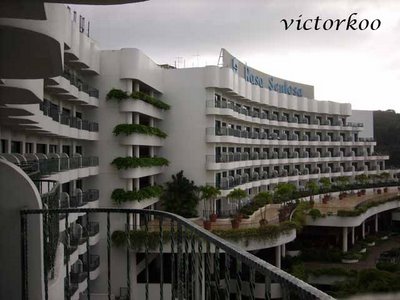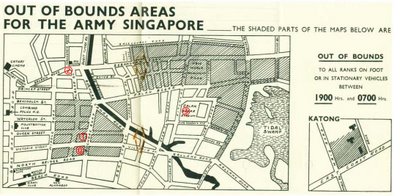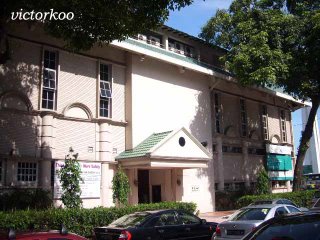 The younger generation may not have any idea who an ice ball man was. (No, he was not an iceman with one ball missing. Nice try though.) The closest modern day equivalent of the ice ball is the ice kacang which is similar in form and substance, but not shape.
The younger generation may not have any idea who an ice ball man was. (No, he was not an iceman with one ball missing. Nice try though.) The closest modern day equivalent of the ice ball is the ice kacang which is similar in form and substance, but not shape.The ice ball was sold at 10 cents during the 1960s. I always patronised a corner stall located at the junction of Albert Street and Queen Street, only a stone's throw from where I lived. This vicinity had a permanent pasar malam (night market) during that time. The stall was operated by a lone Indian man who wore white all the time - turban, shirt and sarong. (Sorry that I didn't check out the colour of his underwear, if any.)
When you tell the man, 'Aneh (brother), ice ball satu (one)', he would shave the ice using one hand by moving a whole block of ice back and forth on top of a homemade wooden ice-shaver that looked like a stool. But don't you ever try sitting on the stool because it had a very sharp blade embedded in it:
 A piece of folded towel was placed on top of the ice block for better grip and also to prevent his hand from getting too cold, I guess. His other bare hand would be cupped under the stool to catch the ice shavings. Plastic or rubber gloves were unheard of at that time. Halfway through, he would fill the centre of the ice shavings with 2 simple ingredients - sweet red beans and chin chow cubes. Then he would continue shaving (the ice, that is) to cover the ingredients. After that, he would shape the product with both bare hands into an almost perfect white ice ball. To put the finishing touches to this classic dessert, he would ladle on sugar syrup of 3 colours (red, green and brown) and then pour some Carnation milk straight out of a tiny hole punched in the top of the can, meanwhile always rotating the ice ball with the other hand to ensure that the milk 'went all around the globe'. I would invariably request him to potong (cut) the ice ball into 2 halves so that I could share the joy (and cost) of eating an ice ball with my neighbour's kid.
A piece of folded towel was placed on top of the ice block for better grip and also to prevent his hand from getting too cold, I guess. His other bare hand would be cupped under the stool to catch the ice shavings. Plastic or rubber gloves were unheard of at that time. Halfway through, he would fill the centre of the ice shavings with 2 simple ingredients - sweet red beans and chin chow cubes. Then he would continue shaving (the ice, that is) to cover the ingredients. After that, he would shape the product with both bare hands into an almost perfect white ice ball. To put the finishing touches to this classic dessert, he would ladle on sugar syrup of 3 colours (red, green and brown) and then pour some Carnation milk straight out of a tiny hole punched in the top of the can, meanwhile always rotating the ice ball with the other hand to ensure that the milk 'went all around the globe'. I would invariably request him to potong (cut) the ice ball into 2 halves so that I could share the joy (and cost) of eating an ice ball with my neighbour's kid.
The best way to eat an ice ball is to eat it with your bare hands. You put the ball to your lips and suck hard. (I am sorry if you find my language a bit crude here.) When most of the syrup has been sucked out of the ball, you bite into the ice and eat the rest of the ball that way. You can finish the ball in 5-10 mins although you always try to make it lasts as long as possible. However, in Singapore's hot weather, 10 mins is about as long as it gets before the ball starts to melt.
 Besides selling ice balls, the Indian man also sold cold drinks. He had a very special drink which was transparent and red in colour. It had some tiny fruit seeds that looked like frog eggs to me. (When you bite into the seeds, they crunch delightfully. I never see this fruit nowadays and I don't know what it is called. Maybe some of my readers can help me out?) By the way, I knew how to get the Indian man to give me some of this flavourful drink for free. This operation required military precision - armed with an empty enamelled mug, I waited for him to close the stall for the day, usually at around 11 pm. Just before he poured the leftover drink from his container into the nearby drain, I intervened and asked pitifully, 'Aneh, kasi sikit boleh? (Brother, can you spare me a bit?) Most times, I managed to get my free drink this way.
Besides selling ice balls, the Indian man also sold cold drinks. He had a very special drink which was transparent and red in colour. It had some tiny fruit seeds that looked like frog eggs to me. (When you bite into the seeds, they crunch delightfully. I never see this fruit nowadays and I don't know what it is called. Maybe some of my readers can help me out?) By the way, I knew how to get the Indian man to give me some of this flavourful drink for free. This operation required military precision - armed with an empty enamelled mug, I waited for him to close the stall for the day, usually at around 11 pm. Just before he poured the leftover drink from his container into the nearby drain, I intervened and asked pitifully, 'Aneh, kasi sikit boleh? (Brother, can you spare me a bit?) Most times, I managed to get my free drink this way.
Photo credit: Credit goes out to the shameless author who is proud that he has the resourcefulness to take the above photos recently at Sentosa's Images of Singapore.

 Beautiful isn't it? I mean not just the lantern but the bonding time I had with my son. And the part my wife played in this? She uttered to me this morning: "Hello, tomorrow school reopens already. And you still have not done the recycling project for your son. Remember to do it today, okay?" See, I told you that mum is responsible for ensuring that the 101 things in the family get done smoothly. And I appreciate her for that. Thanks mum.
Beautiful isn't it? I mean not just the lantern but the bonding time I had with my son. And the part my wife played in this? She uttered to me this morning: "Hello, tomorrow school reopens already. And you still have not done the recycling project for your son. Remember to do it today, okay?" See, I told you that mum is responsible for ensuring that the 101 things in the family get done smoothly. And I appreciate her for that. Thanks mum.

 Actually, my family did consider going for a cruise on this passenger liner instead:
Actually, my family did consider going for a cruise on this passenger liner instead: However, I chickened out after I found out that I had to spend about S$2,000 for our family of 4 to go on a 2-night cruise-to-nowhere that would last less than 40 hours. And at that price, they were giving us a quad-sharing inside-room (which is a room with not even a porthole so you can't tell
However, I chickened out after I found out that I had to spend about S$2,000 for our family of 4 to go on a 2-night cruise-to-nowhere that would last less than 40 hours. And at that price, they were giving us a quad-sharing inside-room (which is a room with not even a porthole so you can't tell 

 Celebrity blogger Kenny Sia had a recent post
Celebrity blogger Kenny Sia had a recent post 
 But I have to agree with Kenny that the resemblance is
But I have to agree with Kenny that the resemblance is  Hmm... the mural must have been erected in honour of the World Cup, in particular, the Teamgeist soccer ball.
Hmm... the mural must have been erected in honour of the World Cup, in particular, the Teamgeist soccer ball.







